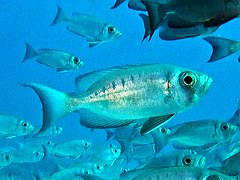Priacanthus hamrur
| Priacanthus hamrur | |
|---|---|

| |
| Scientific classification | |
| Domain: | Eukaryota |
| Kingdom: | Animalia |
| Phylum: | Chordata |
| Class: | Actinopterygii |
| Order: | Perciformes |
| Family: | Priacanthidae |
| Genus: | Priacanthus |
| Species: | P. hamrur
|
| Binomial name | |
| Priacanthus hamrur (Forsskål, 1775)
| |
| Synonyms[2] | |
| |
Priacanthus hamrur, the lunar-tailed bigeye, goggle eye, or moontail bullseye, is a species of marine fishes belonging to the family Priacanthidae.
Distribution[edit]
This species is uncommon but widespread in the Indo-Pacific, from the Red Sea and southern Africa to French Polynesia, southern Japan, and Australia. It has been reported also from Easter Island.[2][3] Two records have been reported from the Mediterranean Sea off Tunisia and Turkey respectively.[4]
Habitat[edit]

Priacanthus hamrur is a reef-associated species, living in tropical marine waters on outer reef slopes and rocky areas and in lagoons at depths of 8 to 250 meters, but most commonly from 30 to 50 m.[2][1]
Description[edit]
At sexual maturity the size of Priacanthus hamrur reaches 18–19 cm (7.1–7.5 in) in males, 19.1–20.0 cm (7.5–7.9 in) in females,[1] but males can reach a maximum length of 45 cm.[2] The body of the Crescent-tail Bigeye is relatively deep, strongly compressed laterally. The eyes are very large and red (even in case of silver livery). The mouth is oblique with a protruding lower jaw and small conical teeth. The extremity of the lower lip is above the median line of the body.[5] The dorsal fin has 13 to 15 soft rays. The pelvic fins are very large. The caudal fin has a concave indented margin which may be crescent-shaped (hence the common name).[2]
The body of these fishes goes through various phases of color, which may vary from orange to entirely red or entirely silver, or silver with broad six red bands (the first red bar crosses the eye).[5] It is also capable of quickly changing the color. Sometimes it has a row of about fifteen small dark spots along the lateral line[5] or large spots on upper side. The fins are red to light pink.[2]
This species is rather similar and can be confused with Priacanthus blochii and with Heteropriacanthus cruentatus. Both these last species have the caudal fin only slightly rounded.[5]
-
Crescent-tail Bigeye in silver phase
-
Barred colour phase
-
Entirely red phase
-
A shoal of Crescent-tail Bigeyes
Biology[edit]
Priacanthus hamrur feeds primarily at night on small fishes and small crustaceans and various invertebrates (small cephalopods, shrimp, crabs, polychaete worms, etc.).[2][1][5] These fishes can be found throughout the year, with a peak in the month of August.[6] Eggs, larvae and very young juveniles are pelagic.[5] These fishes usually live solitary, but the may also form small aggregations and sometimes large schools in the open waters.[1]
Bibliography[edit]
- Madhusoodana, K. B. and S. Venu. (2006). Length-weight relationship of Priacanthus hamrur (Forsskål) inhabiting the continental slopes beyond 300m depth along the west coast of India. Fishery Technology 43(1).
- Allen, G.R. 1997. Marine Fishes of Tropical Australia and South-east Asia. Western Australian Museum. Pp. 292.
- Fricke, R. (1999) Fishes of the Mascarene Islands (Réunion, Mauritius, Rodriguez): an annotated checklist, with descriptions of new species., Koeltz Scientific Books, Koenigstein, Theses Zoologicae, Vol. 31:759 p.
- Kuiter, R.H. 1996. Guide to Sea Fishes of Australia. New Holland. Pp. 433.
- Kuiter, R.H. 2000. Coastal Fishes of South-eastern Australia. Gary Allen. Pp. 437.
- Monkolprasit, S., S. Sontirat, S. Vimollohakarn and T. Songsirikul (1997) Checklist of Fishes in Thailand., Office of Environmental Policy and Planning, Bangkok, Thailand. 353 p.
- Nguyen, N.T. and V.Q. Nguyen (2006) Biodiversity and living resources of the coral reef fishes in Vietnam marine waters., Science and Technology Publishing House, Hanoi.
- Paxton, J.R., D.F. Hoese, G.R. Allen and J.E. Hanley (1989) Pisces. Petromyzontidae to Carangidae., Zoological Catalogue of Australia, Vol. 7. Australian Government Publishing Service, Canberra, 665 p.
- Randall, J.E., Allen, G.R. & R.C. Sateen. 1997. Fishes of the Great Barrier Reef and Coral Sea. Crawford House Press. Pp. 557.
- Starnes, W.C., 1988. Revision, phylogeny and biogeographic comments on the circumtropical marine percoid fish family Priacanthidae. Bull. Mar. Sci. 43(2):117-203.
References[edit]
- ^ a b c d e Carpenter, K.E.; Lawrence, A.; Myers, R. (2016). "Priacanthus hamrur". IUCN Red List of Threatened Species. 2016: e.T46087863A46664864. doi:10.2305/IUCN.UK.2016-3.RLTS.T46087863A46664864.en. Retrieved 20 November 2021.
- ^ a b c d e f g Froese, Rainer; Pauly, Daniel (eds.) (2019). "Priacanthus hamrur" in FishBase. December 2019 version.
- ^ Discover Life
- ^ Atlas of Exotic Fishes in the Mediterranean Sea (Priacanthus hamrur). 2nd Edition. 2021. 366p. CIESM Publishers, Paris, Monaco.https://ciesm.org/atlas/fishes_2nd_edition/Priacanthus_hamrur.pdf
- ^ a b c d e f DORIS -Données d'Observations pour la Reconnaissance et l'Identification de la faune et la flore Subaquatiques (in French)
- ^ iNaturalist
External links[edit]
- Photos of Priacanthus hamrur on Sealife Collection
- Lunartail Bigeye, Priacanthus hamrur (Forsskal 1775) @ fishesofaustralia.net.au





